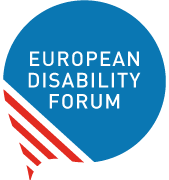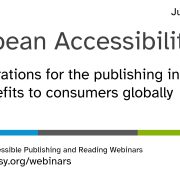Inclusive Publishing Hearts and Minds at the Digital Publishing Summit
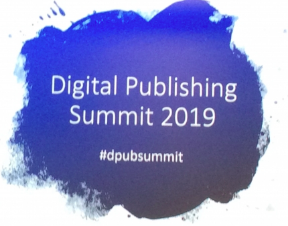 The 2019 edition of the Digital Publishing Summit took place in Paris (France) on June 25-26. This increasingly popular two-day conference—now in its fourth iteration—is organised by the not-for-profit organization EDRLab (European Digital Reading Lab). The conference began in 2016 in the town of Bordeaux (France), then moved to Brussels (Belgium), followed by Berlin (Germany).
The 2019 edition of the Digital Publishing Summit took place in Paris (France) on June 25-26. This increasingly popular two-day conference—now in its fourth iteration—is organised by the not-for-profit organization EDRLab (European Digital Reading Lab). The conference began in 2016 in the town of Bordeaux (France), then moved to Brussels (Belgium), followed by Berlin (Germany).
This year’s opus was hosted by the National Library of France, in the capital city where EDRLab’s headquarters are located and has, yet again, been a showcase of some of the most exciting developments in the industry. The two conference days were packed with in-depth presentations as well as entertaining insights on the many facets of the publishing ecosystem. Business managers and technical experts shared their experiences, and reflected on the challenges and opportunities that have marked the year.
The extensive program covered a broad spectrum of topics, including:
- The essential role of technical open standards—the EPUB specifications, the W3C web platform, and the global collaboration to normalize digital sequential art / visual narratives (comic books, manga)
- The strategic significance of open source software—EPUBCheck and the Ace by DAISY Accessibility Checker
- Innovative research and development projects coming to fruition and the growing adoption of Readium architecture in commercial-grade solutions
- User-friendly Digital Rights Management gaining traction in the library context—Readium LCP (Licensed Content Protection)
- The emergence of bleeding-edge software solutions and services, automated production processes powered by machine learning principles
- Changing consumer habits and evolving business models including the remarkable expansion of the audio-books market
- Legal directives and legislative frameworks, ensuring inclusive access to all published content—the European Accessibility Act and the ongoing ratification and implementation of the Marrakesh Treaty
This short article only touches the surface of some of these topics, so make sure you explore the YouTube video recordings of the conference talks.
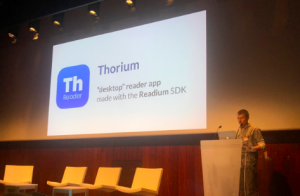
Image supplied by Luc Audrain, Hachette Livre
I personally made a presentation about Thorium, an open-source desktop application based on the Readium architecture. Thorium is a reading system developed by EDRLab, which aims to support EPUB (reflowable and fixed layout), the LCP DRM, OPDS catalogs, TTS read aloud, accessible annotations, and many other essential features. I talked about usability, as well as the technical challenges faced when implementing accessibility techniques (e.g. keyboard navigation, screen reader support, customizable text formatting, adaptable user interface, etc.). Aferdita Muriqi (EDRLab) showcased the Readium mobile apps, with the notable addition of support for audio books. Naturally, accessibility is also high on the priority list of the Android and iOS projects.
Over the past few years, the digital publishing industry has demonstrated a passionate drive to create systems with inclusive design in mind, impacting not only the reading experience end of the supply chain, but throughout the entire ecosystem—authoring tools, production practices, validation utilities, delivery and discovery systems, and of course technical standards and publication formats.
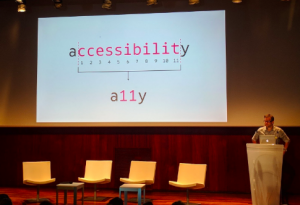
In the first slide of his presentation, Ken Jones (Circular Software) showed how the word accessibility contracts to the term a11y. Ironically, Ken immediately went on to make live demonstrations of interactive, animated, all singing-and-dancing fixed layout EPUB publications, which usually rate low on the a11y-o-meter! However, Ken made the case that documents authored with Adobe’s InDesign—a tool typically geared towards visual typesetting and graphic-oriented creations—can indeed feature a clean navigation structure and linear reading order. Ken showed keyboard usage and gave an example of accessible text in typographically-rich layouts. He also explained how to label interactive controls so they are announced by screen readers as well as demonstrating EPUB Media Overlays read aloud— the playback of audio narration synchronized with highlighted text.
There is indeed a strong case to be made for optimized publications – as defined in the EPUB Accessibility specification, for example those that meet the particular needs of readers with dyslexia, using adapted typography, text formatting, colours, and synchronized voice narration, etc.
However, fixed layout EPUBs have an intrinsic characteristic that makes them inherently less accessible than their reflowable counterparts: they are not authored with responsive design in mind. By definition, a fixed layout document is not meant to reflow depending on screen size and device orientation. At best, it can be scaled in or out, and panned across. Crucially, in the real world, many fixed layout publications are just mere exports from typesetting tools like InDesign, or straight conversions from PDF with little or no care for accessibility.
A case in point: Vincent Wartelle (ISICrunch) gave an entire presentation about using machine learning—more commonly referred-to as artificial intelligence—to reverse-engineer the navigation structure, linear reading order, and text flow from PDF files typically published in the education sector. In my opinion, although there are valid justifications for fixed layout EPUBs, I believe the first port of call for any modern digital creation should be a reflowable responsive design.
Thankfully, nowadays there are readily-available tools to help validate publications not only in terms of their correctness with respect to the EPUB specification (i.e. EPUBCheck), but also by asserting a number of well-defined accessibility criteria. As Romain Deltour (DAISY Consortium) demonstrated, the Ace by DAISY Accessibility checker verifies W3C WCAG rules as well as EPUB-specific ones. The report produced by Ace contains a list of categorized and prioritized issues, which content creators can use to identify problems and address them effectively (references to the DAISY Knowledge Base are provided).
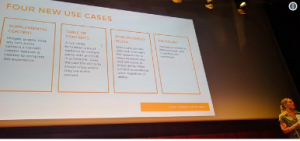 I anticipate that in some not-too-distant future, there will be similar validation/checking tools to help with the production of audio books. In her presentation, Wendy Reid (Kobo) walked us through the W3C audio books standardization effort, which includes a strong recognition of the need for a structured table of contents (not just a playlist of MP3 files!), accessible descriptions, as well as the potential of more advanced features like escapability and skippability (which are well-known concepts in DAISY Digital Talking Books)
I anticipate that in some not-too-distant future, there will be similar validation/checking tools to help with the production of audio books. In her presentation, Wendy Reid (Kobo) walked us through the W3C audio books standardization effort, which includes a strong recognition of the need for a structured table of contents (not just a playlist of MP3 files!), accessible descriptions, as well as the potential of more advanced features like escapability and skippability (which are well-known concepts in DAISY Digital Talking Books)
Many of the presentations at the Digital Publishing Summit did not have a direct accessibility angle, which made them no less interesting. Julie Blanc (Labo Paragraph) talked about “page.js”, an HTML toolkit for print layout based on CSS stylesheets. Florian Dupas (Kwalia) presented the latest research and development in the field of digital comic books – sequential art / visual narrative – a collaborative effort that involves participants from several countries (notably Japan, where manga is a popular art form, and a vibrant market).
Conversely, a whole portion of the conference was dedicated to discussing inclusive access, head-on. Notably, Cristina Mussinelli (LIA Foundation) provided an overview of the Marrakesh Treaty and the European Accessibility Act. Avneesh Singh (DAISY Consortium) talked about the global accessibility specifications that are used to implement the legislative requirements.
To conclude, here is a quote from one of Avneesh Singh’s slides:
We are in the beginning of a revolution, we have a lifetime opportunity to achieve the era of born-accessible publications.
Let’s come along for a common worldwide standard for accessible publications
We certainly are. We certainly should.

This article was kindly submitted by software engineer, Daniel Weck, who works with the DAISY Consortium and EDRLab to implement accessible open source production tools and reading systems. Daniel also contributes to the standardization of web technologies and open publication formats, with a particular focus on inclusive publishing.


